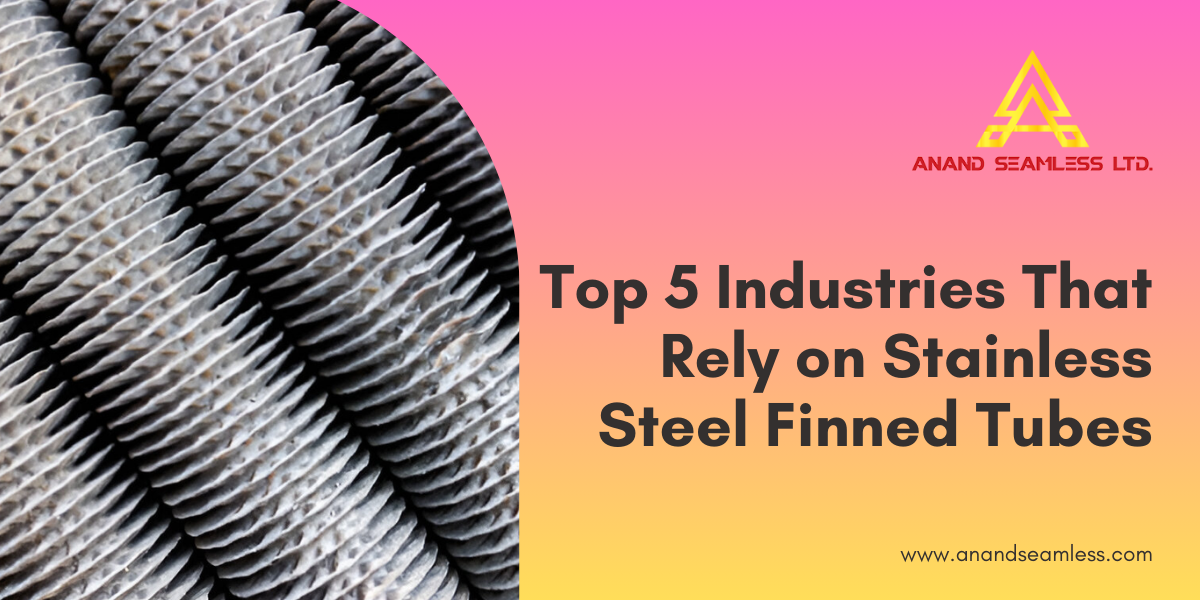Quick Inquiry
In heat transfer and thermal management, stainless steel finned tubes play a pivotal role. Known for their durability, corrosion resistance, and excellent thermal conductivity, these components are indispensable across several industries. By enhancing the surface area for heat exchange, finned tubes optimise efficiency and energy savings—making them essential for businesses striving for operational excellence.
For enterprises that require heat exchangers, boilers, condensers, or air coolers, stainless steel finned tubes are not just components; they are long-term solutions. This article explores the top five industries that heavily rely on these specialised tubes to improve system performance and drive productivity.

5 Most Common Applications of Stainless Steel Finned Tubes
1. Power Generation Industry
Power plants—be it fossil fuel, nuclear, or renewable—depend on efficient heat exchange systems to convert energy into electricity. Heat recovery is central to these processes, and finned tubes are used extensively in heat exchangers, economisers, and air preheaters.
Key Applications:
- Boilers and Economisers: Finned tubes are integrated into economisers to recover waste heat from flue gases, improving fuel efficiency and reducing emissions.
- Air-Cooled Heat Exchangers: Especially useful in areas with limited water resources, these systems rely on stainless steel finned tubes for effective air-to-fluid heat transfer.
Advantages:
- Excellent resistance to high temperatures and corrosive environments
- Long service life, reducing maintenance downtime
- Enhanced thermal conductivity leading to more efficient fuel use
2. HVAC and Refrigeration Industry
Heating, ventilation, and air conditioning (HVAC) systems require reliable and efficient components to maintain thermal comfort in residential, commercial, and industrial buildings. Stainless steel finned tubes are crucial in air handling units and refrigeration systems.
Key Applications:
- Evaporators and Condensers: Finned tubes increase the contact surface area, boosting the heat exchange rate in both cooling and heating applications.
- Heat Pumps and Dehumidifiers: Used to regulate temperatures efficiently in various climatic conditions.
Advantages:
- Stainless steel finned tubes offer corrosion resistance, especially in humid or coastal environments
- Lower energy consumption due to improved heat transfer
- Compact designs enable installation in space-constrained environments
3. Petrochemical and Chemical Industry
The chemical processing industry involves aggressive fluids, high pressures, and extreme temperatures. Heat exchangers made with stainless steel finned tubes withstand these conditions while ensuring safety and process stability.
Key Applications:
- Reboilers and Air-Cooled Heat Exchangers: Used in distillation and cooling operations to regulate process temperatures.
- Sulfur Recovery Units and Gas Coolers: Vital in refining operations, where corrosive gases and fluids are commonplace.
Advantages:
- Superior resistance to corrosive chemicals and high-temperature steam
- Reduced risk of tube failure, enhancing plant safety and uptime
- High-efficiency heat exchange contributes to product quality and energy savings
Talk to a Technical Expert Now
4. Food and Beverage Industry
In food and beverage processing, cleanliness, temperature control, and energy efficiency are top priorities. Stainless steel finned tubes are ideal due to their hygienic properties and excellent thermal performance.
Key Applications:
- Pasteurisers and Heat Recovery Units: Ensure consistent heating for milk, beer, juices, and other liquids.
- Refrigeration Systems: Maintain optimal temperatures during food storage and transportation.
Advantages:
- Non-reactive surface prevents contamination, meeting food-grade standards
- Resistant to frequent cleaning and sanitation cycles
- Enables energy savings through effective heat recovery and transfer
5. Marine and Offshore Industry
Marine applications, from ships to offshore oil rigs, demand heat exchangers that can withstand salty, humid, and abrasive environments. Finned tubes made of stainless steel are particularly suited for these harsh conditions.
Key Applications:
- Marine Boilers and Cooling Systems: Manage engine temperatures and steam generation on vessels.
- Desalination Plants: Used in evaporators and condensers to produce potable water from seawater.
Advantages:
- High resistance to saltwater corrosion ensures long operational life
- Withstand mechanical stress from constant motion and vibration
- Lightweight yet durable—perfect for space-constrained marine installations
Why Stainless Steel Is the Material of Choice
Beyond their widespread use, stainless steel finned tubes offer material-specific advantages that make them a top pick across industries:
- Corrosion Resistance: Stainless steel’s passive layer prevents oxidation, making it suitable for aggressive environments.
- Thermal Performance: Finned tubes increase surface area, and stainless steel efficiently transfers heat with minimal losses.
- Mechanical Strength: Withstands high pressure and temperature, maintaining structural integrity over time.
- Low Maintenance: Their longevity and resistance to wear and tear reduce the need for frequent servicing or replacement.
- Hygienic Properties: Ideal for sanitary applications, particularly in food and pharmaceutical sectors.
FAQs
1. What factors should businesses consider when selecting stainless steel finned tubes for their applications?
When choosing stainless steel finned tubes, businesses should consider factors such as operating temperature, pressure conditions, fluid properties, and environmental exposure. It’s also important to evaluate the fin type (e.g., L-type, G-type, embedded, or extruded) based on the required heat transfer efficiency and mechanical strength.
2. Are stainless steel finned tubes customisable for industry-specific applications?
Yes, leading manufacturers offer a range of customisations including tube size, fin height, fin density (fins per inch), tube material grades (such as SS304, SS316), and surface treatments. Custom configurations help industries like petrochemical, marine, and HVAC meet their unique thermal performance and space requirements.
3. How do stainless steel finned tubes contribute to sustainability goals?
Stainless steel finned tubes enhance energy efficiency in heat exchange systems, which directly contributes to lower fuel consumption and reduced carbon emissions. Their long lifespan and recyclability also make them an environmentally responsible choice for companies aiming to meet ESG and sustainability targets.
4. Can stainless steel finned tubes handle frequent thermal cycling?
Absolutely. stainless steel has excellent thermal fatigue resistance, making finned tubes suitable for systems that undergo constant heating and cooling cycles. This property ensures consistent performance and reduces the risk of material degradation or tube failure over time.
Maximise Efficiency with Premium Stainless Steel Finned Tubes
Looking to elevate the performance of your heat exchange systems? At Anand Seamless Limited, our stainless steel finned tubes are engineered to deliver superior thermal efficiency, long-term durability, and outstanding resistance to corrosion—making them the ideal solution for demanding industrial applications. Whether you’re in power generation, HVAC, petrochemicals, or marine operations, our tubes are designed to meet your specific operational needs with precision and reliability.
Don’t let energy losses and maintenance downtimes impact your bottom line. Partner with a trusted Indian manufacturer and exporter committed to quality, customisation, and performance.
Ready to optimise your processes? Connect with our technical experts today at +91-9099996853 to find the perfect stainless steel finned tube solution for your industry. Let’s work together to boost your productivity and reduce energy costs—one high-performance tube at a time.
lATEST BLOG |
|
Finned Tube Heat Exchanger Selection Guide for Rice Mills, Dairy and Food Plants in India
A finned tube heat exchanger is one of the most im |
|
Why Cold-Drawn Tubes Are the Best Choice for Aerospace Component Manufacturing
When it comes to aerospace manufacturing, the sele |
|
How Seamless Steel Pipes Ensure Safety in High‑Pressure Boiler Systems
When it comes to ensuring the safe operation of hi |
|
Why Seamless Tubes and Pipes Are Gaining Popularity in Heavy-Duty Industries
In the world of heavy-duty industries, where high |
|
How Finned Tubes Help Combat Fouling in Heat Exchangers: Solutions for Clean Heat Transfer
Heat exchangers are the heart of many industrial s |

